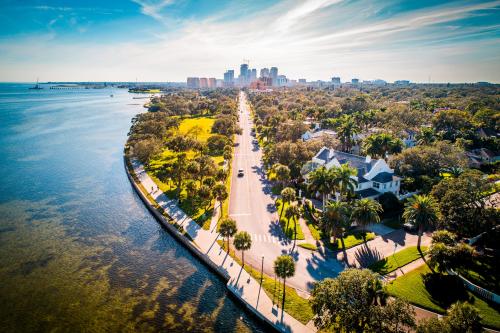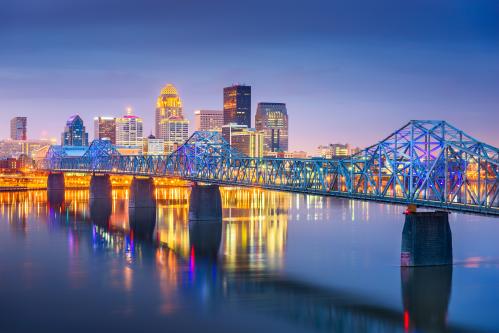How can a city-region achieve visibility and distinguish itself in the international marketplace? This question emerged as the most consistent challenge across nearly 30 metropolitan trade and investment plans created through the Global Cities Initiative (GCI). Responding to this need, GCI undertook a pilot project to develop a replicable process and menu of strategies for metropolitan leaders to more effectively define and communicate their region’s global identity.
The ability to project a distinctive global identity is critical in connecting with trade, investment, and talent opportunities in an increasingly competitive environment. In the second half of the 20th century, U.S. city-regions enjoyed the benefits of rapid domestic growth, leading the world on innovation, production, and attracting enterprising migrants. But disruptions from rapid globalization, urbanization, agglomeration, and technological change enabled more mobile commerce, capital, talent, and invention, which pushed midsized metropolitan areas into new rivalries around the world. As affirmed in “The Ten Traits of Globally Fluent Metro Areas,” the metropolitan areas with the best records at working globally possess a combination of appealing identity, high standards, reputation, and global relevance in specific markets. To be heard, they project a unique, consistent, and authentic message that differentiates them from other cities.
The names of cities such as London, San Francisco, Paris, Tokyo, New York, and Singapore resonate beyond their national boundaries. They have a global recognition that conjures a powerful set of ideas as a place to visit, study, innovate, and do business. But other cities similarly recognizable by name—such as Philadelphia—may send only blurry signals about their true offerings. Historic narratives and urban myths often misrepresent reality. Many regions that would be important economic centers in any other country have limited visibility to foreign audiences. And within a metro area, leaders and residents can have a set of preconceived ideas about their city-region that fails to reflect its actual assets.
To appear on the global radar, city-regions must achieve greater visibility that accurately conveys their local assets and competitive advantages. They must establish a more legitimate sense of how they are both perceived and positioned. They must overcome the fragmentation of institutions that sees marketing roles running multiple campaigns that create a confusing picture and waste resources, and instead assemble diverse stakeholders around a cohesive, consistent narrative. They must unify convention and tourism appeals, investment attraction, talent recruitment, and trade promotion. These activities require new approaches to communicate both sector-specific strengths and distinct character that differ from standard marketing tactics such as slogans and advertising in site-selection magazines.
Establishing and communicating a unified identity not only positions the metro area for global competition, but shapes a common purpose for the region’s stakeholders as well. Beyond effective external opportunities, identity development provides leaders with the glue that can bond people and institutions in a common spirit and mission for joint action on a wide range of internal objectives.
DEFINING CITY IDENTITY
The concept of city identity is confusing because it is used interchangeably with branding, marketing, and design, cutting across the responsibilities of economic development organizations, tourism agencies, universities, mayoral offices, and other stakeholders. It is not about having a slogan, logo, or sales pitch to attract companies and visitors; rather, identity is the foundation for these activities and the essence behind them (Figure 1).
A city-region’s identity is its DNA: a unique, inherited collection of assets, history, traits, and culture that distinguishes it internally and externally, and has the potential to unite people and place.

A city’s identity can be likened to that of a person’s identity. Everyone has their own genetic makeup, character, and lived experience that define them as an individual. Based on this identity, people choose to represent themselves through their personal brand in how they dress and what stories they tell. People have reputations based on how they are perceived by others, which may not be realistic of their qualities. People’s visibility depends on how many know them and what social circles they move in. Building and projecting a clear and accurate global identity requires intentional, collective effort among all regional stakeholders based on evidence and common objectives.
The approach for developing a city identity
The report draws from international case studies, input from global experts, and lessons learned from an 18-month pilot project in which the Brookings Metropolitan Policy Program worked with four U.S. metropolitan areas (Atlanta, Columbus, Ohio, Louisville, Ky., and Philadelphia) to create a framework and tools for approaching global identity development. The framework contains three phases that are broken into seven tasks with suggested considerations and outputs (Figure 2).

A core finding from the GCI pilot and case study research is that uniform or rigid solutions cannot be transferred across regions. Failed efforts most often involved a small group of city officials or branding consultants trying to replicate something that worked elsewhere. While the processes, questions, or considerations might be similar, the actual depth, staging, and format of phases and tasks will be determined by local objectives and circumstances.
THE SEVEN TASKS for global identity development
Task 1. Assess the need
Case-making precedes identity-building. From the outset, metropolitan leaders must assess the challenges around the current identity and communication strategy of their regions and consider the objectives that would be addressed. Is the identity known and understood, and by whom? How strong is the identity relative to assets? What are the costs or weaknesses of the current approach? What are the gaps to bridge or opportunities to take? Common challenges include negative images, fictions, or myths about the city-region that have been perpetuated, as well as unrecognized assets and confusion around the city narratives being told.
Task 2. Set the objectives
Inspiring the motivation to do the work also requires setting clear objectives for building a global identity. These objectives may change alongside the process. Overall, a compelling global identity aims at influencing specific audiences—business and investment, visitors, education, civic, cultural, etc.—in the short and longer terms for internal and external benefits. Common objectives include enhancing the city-region’s business trajectory, increasing its appeal and reputation to attract investments and visitors, and improving confidence and resilience. Tactically, identity can improve strategy, spending, and governance. Broadly, identity can captivate and recruit the world.
Task 3. Organize the region’s stakeholders
Building a global identity requires a strong and diverse alliance of regional actors. Although they may not consider themselves marketers of the city-region, many different groups can contribute to a more effective identity. Metro areas must inventory the organizations and individuals with a stake in the region’s identity effort and choose how best to engage them. Organizing this identity “alliance” at the outset syncs the action of disparate organizations in the region and ensures they are willing to build a coherent, cooperative effort.
Task 4. Diagnose
Metropolitan leaders do not concoct a global identity from scratch. Identity stems from a metro area’s unique DNA and the ways it has evolved and been perceived across its existence. Thus, stakeholders must know the region’s distinctive features and historical roots. They also must fully understand its external reputation by completing a global perception review, and assess the region’s performance in winning opportunities compared to its peers. This identifies the gaps between what the region should be known for, how the world sees it, and how it is promoted. Establishing how residents see their own region is essential to uncovering its identity, and can enlist those residents to support and project the identity later.
Task 5. Develop the identity
After the diagnosis and perception analyses, a metro area must undertake an iterative process to translate values and assets into a narrative that resonates with internal and external target audiences. A narrative matrix can help define and apply the identity to different sectors and target audiences by linking it to practical applications for individual stakeholders and using case studies and practical situations to adapt the core identity to the lens of specific audiences. Regional stakeholders also distill the city’s narratives into an “identity statement,” or a common description of the essence and distinctive character of the city. This often is presented as a story that defines the region’s history, assets, and personality in a way specific enough so that an informed audience could guess what city it is without seeing the name.
Task 6. Plan
Building momentum and assuring implementation requires realistic timelines, governance, and financing decisions. Throughout the identity-building process, they should consider resource constraints, management, capacities, and funding models. Regional teams should also determine how to collaborate on shared identity tasks, figuring out what needs to be done collectively and who is individually responsible for what. They should anticipate legal requirements for protecting the intellectual property and branding materials developed in the process.
Task 7. Promote
Projecting the identity requires novel tactics and programmatic interventions as well as engaging new champions who can amplify and achieve broader reach with limited resources. Progress must be measured throughout. Cities can develop a global identity strategy and implementation workplan in some locally useful format, segmenting and prioritizing activities to apply the identity in the short and longer terms. The workplan also codifies overall tactics, operational commitments, and performance metrics. Sample approaches include creating a shared “brand box” of messaging and information, with user training; recruiting externally facing business or civic champions; organizing the region’s diaspora and alumni; initiating identity-related awards; and aligning major event targets with economic development objectives. Metrics not only measure efficiency, they also constitute a key justification of the value of global identity activities and legitimize the case for resources.
Why cities need to develop their global identity
In an increasingly urban and economically integrated world, people and ideas move rapidly from location to location. City-regions, therefore, should understand and communicate the core identity that lies behind their appeal. Along the way, they can recruit their residents and other stakeholders to be active champions, and better leverage marketing resources. Cities that convey distinctive and differentiating character based on a coherent, genuine identity are more competitive and gain new opportunities—once the world knows their story.









